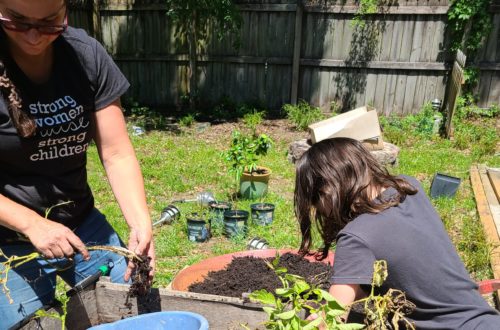Why Start With Chickens?
Why start with Chickens?
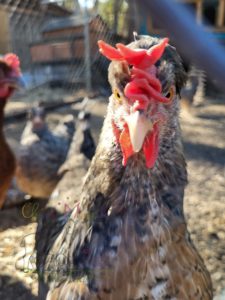
Regardless of whether you are a brand new homesteader or a seasoned veteran, whether you have a large farm or an urban garden, it’s likely that you already know, the first livestock for most homesteaders are chickens. This was true for us at Chaos Magik Homestead as well. Truly, before we even knew homesteading would become such an integral part of our lives, we had eggs in an incubator.
For us, starting with chickens was a circumstance of convenience, education, and economic practicality. And, for most people just starting out, one or more of these reasons are why they started with chickens as well.
CONVENIENCE…
Convenience can be broken into a few different categories. First, chickens are convenient to find and purchase. Sure, there are lots of hatcheries and plenty of people selling through Facebook poultry and farm groups, but chicks are also available every spring at nearly every feed store or farm store in every community! So, avoiding the hassle of online scams or locating reputable breeders can be nearly painless. Sure, the chicks you pick up at your local farm store chain probably aren’t the ideal breeding stock for your future hatchery… but let’s be honest, you’re probably not starting with the goal of managing your own breeding program; that will come later, when chicken-math gets the best of you!
Chickens are also convenient to manage. Unlike other livestock that need lots of space, high end fencing, and feed storage space, chickens can fare well with minimal space, minimal fencing and a garbage can for storing feed. A medium breed chicken, like most high egg production birds, needs about 4 square feet of coop space per bird and about 8 square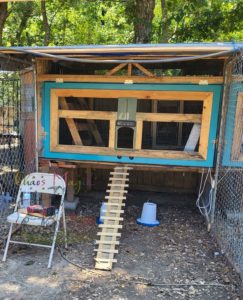 feet of run (if they aren’t free ranging). Let’s imagine you want to start your flock with a variety of egg colors from high-producing chickens, so you go to the local feed store this spring and get some Easter Eggers! These birds
feet of run (if they aren’t free ranging). Let’s imagine you want to start your flock with a variety of egg colors from high-producing chickens, so you go to the local feed store this spring and get some Easter Eggers! These birds  will lay about 280 eggs a year. Divide that by 365 days in a year and multiply by 7 days in a week (no, you don’t have to do the math, I’ve got you covered!) and you find that one Easter Egger will provide you with a little over 5 eggs a week! Okay, cool. Now, imagine you have a family of 4, each member eats 2 eggs a day for breakfast. A bit more math, or just trusting my math, shows you that you need 10-12 chickens to provide eggs for your family’s weekly needs. To achieve that, you’re going to need a 40 to 48 square foot coop like a 4 by 10 or 6 by 8. That’s not a lot of space, but if you’re struggling to find it, you can always build up off the ground a few feet so the chicken yard can incorporate the space under the coop as well.
will lay about 280 eggs a year. Divide that by 365 days in a year and multiply by 7 days in a week (no, you don’t have to do the math, I’ve got you covered!) and you find that one Easter Egger will provide you with a little over 5 eggs a week! Okay, cool. Now, imagine you have a family of 4, each member eats 2 eggs a day for breakfast. A bit more math, or just trusting my math, shows you that you need 10-12 chickens to provide eggs for your family’s weekly needs. To achieve that, you’re going to need a 40 to 48 square foot coop like a 4 by 10 or 6 by 8. That’s not a lot of space, but if you’re struggling to find it, you can always build up off the ground a few feet so the chicken yard can incorporate the space under the coop as well.
Chickens are convenient to feed. Above all things, feeding chickens is one of the BEST advantages to having them on the homestead. Chickens eat nearly EVERYTHING! Sure, it’s a little stressful at first, especially when you look through blog after blog telling you what chickens can’t eat… but, honestly, I’ve never lost a chicken because it ate a nightshade. 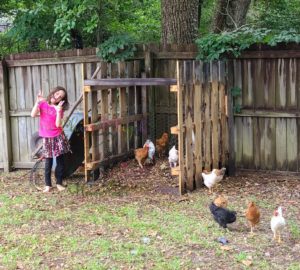 Chickens are great at managing the bug population in your back yard, cleaning up your kitchen scraps, discarding your garden scraps and, best of all, TURNING YOUR COMPOST! Yes, I feed my chickens pelleted feed year around, but I keep it minimal and let them work for the rest. One of the ways I facilitate their health is by keeping a compost pile where they can access it. Yes, it does get a little messy, but it’s well worth it! I throw all of my kitchen scraps, as well as some of the neighbors’ scraps into the pile. When I let the chickens out in the morning to free-range, that is the first place they go. They will toss through, eat what they want and leave the rest to the bugs. Then, the bugs will come to help with composting and the chickens will eat the bugs too! All I have to do is go out a couple times a week and rake the mess back into a pile. This process is so much less work than turning compost and it saves a ton on feed expenses!
Chickens are great at managing the bug population in your back yard, cleaning up your kitchen scraps, discarding your garden scraps and, best of all, TURNING YOUR COMPOST! Yes, I feed my chickens pelleted feed year around, but I keep it minimal and let them work for the rest. One of the ways I facilitate their health is by keeping a compost pile where they can access it. Yes, it does get a little messy, but it’s well worth it! I throw all of my kitchen scraps, as well as some of the neighbors’ scraps into the pile. When I let the chickens out in the morning to free-range, that is the first place they go. They will toss through, eat what they want and leave the rest to the bugs. Then, the bugs will come to help with composting and the chickens will eat the bugs too! All I have to do is go out a couple times a week and rake the mess back into a pile. This process is so much less work than turning compost and it saves a ton on feed expenses!
EDUCATION…
So many homesteaders keep chickens simply for their convenience, but the number one reason we started with chickens was for educational reasons. At the time we began this journey, I was homeschooling three of our four children. It truly was CHAOS! My kiddos have quite the age gap, so while I had two in high school, I had one in first grade… it was impossible to find things for them to work on together and science was one thing I wanted them to all be able to really get their hands dirty with. But, even though I wanted them to do all of the chemistry experiments and such, I also really wanted them to dive into every-day, practical science. We did lots of cooking and baking, but we were losing inspiration. Then, one day, the kids went to Tractor Supply with their grandmother and came home gushing over the cute chicks they saw… and I was inspired! Fortunately, my husband had a friend who owned chickens and had an incubator just sitting around… he was more than willing to let us borrow it and even supplied us with a couple dozen eggs. The first step of our education began with setting up the incubator. Setting up the incubator was a great opportunity for the kids to learn some important lessons like:
-
-
-
-
-
-
-
-
- How long does it take a egg to hatch?
- How do you know if an egg is fertile?
- What temperature does an egg need to be at for a chick to develop?
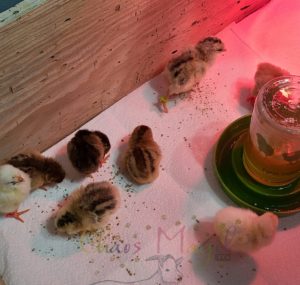
- What role does humidity play in hatching an egg?
- What does a chick look like at each stage of incubation?
-
-
-
-
-
-
-
These questions were fun to explore and we were able to find some really cool videos to help with the visuals. Once the incubator was set up, we had 21 days to get everything ready! This was a great time to step into our second stage of education: what do chickens need to survive? While waiting for the eggs to hatch, we were able to learn all about:

-
-
-
-
-
- How to candle an egg
- How to brood chicks
- How to sex chicks
- What is a Cockerel and a Pullet?
- How long does it take a chick to ‘feather out’
- Chicken nutrition
- Chicken housing
- Chicken healthcare.
-
-
-
-
I’d like to say that we had a coop and chicken run before we ever began incubating eggs, but I’d be lying! We did not have our poultry in a row (hahaha)… and if we did, we wouldn’t be Chaos Magik! But, now that I’ve admitted to poor planning, step three of our educational journey was learning how to build a chicken coop out of pallets! During this phase, which never seemed to end (thank you chicken math) we learned about:
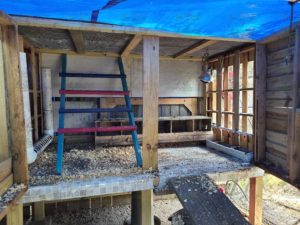
-
-
-
-
-
-
-
-
- How much space a chicken needs?
- Why is good ventilation so important?
- What is the best bedding?
- What cleaning method works best for us?
- Should we hang feeders inside the coop?
- Should we provide water inside the coop?
- How to get a chicken to put itself up at night!
-
-
-
-
-
-
-
ECONOMIC PRACTICALITY…
The final reason we, and many other homesteaders, began with chickens was because they are relatively inexpensive.
First, they are inexpensive to purchase. Sure, you can get that perfectly bred $6,000 Ayam Cemani that you won’t ever want out of your sight because… $6,000! But, let’s be real, you don’t need an all black chicken with weird black meat that, despite what TikTok says, still lays a cream-colored egg… you just need some cute fluffy, preferably female, chicks that will lay eggs and eat your chicken scraps. These chicks, generally cost about $3-$6 each and are perfectly suited to keep you smiling and eating a healthy breakfast.
Likewise, in comparison to other livestock, they are relatively inexpensive to house. Like beauty, expensive is in the eye of the beholder! And, you can spend as much as you want on that perfect coop… but you can also build it for next to nothing. The most expensive material in our chicken coops (we have 7 of them) is the hardware cloth. Our first coop was built out of pallets that we picked up off the side of the road and had a tarp that we got for $15 from Harbor Freight for the roof. Was that the ideal roofing? No, but it got us started when the budget was super tight and it lasted 2 years before we had to replace it. In fact, we have started most of our barns and coops with tarps while we have scavenged and saved for other roofing materials. All in all, our first coop was 4ft x 8ft and cost us a total of $75 to build! Likewise, you can spend a fortune on feeders and waterers, or you can use scraps to craft your own creative devices. We are all about ingenuity around Chaos Magik Homestead!
Finally, chickens are inexpensive to feed. Granted, I must preface by saying “before I had chickens, I had large breed dogs”. So, inexpensive is true, but maybe more true for me than someone who’s only ever fed goldfish! Still, a 50lb bag of laying pellets at my local feed store cost’s me $14. Living in the deep south, I have the advantage of allowing my chickens to free range most of the year which also helps offset feed cost. But, if you follow my recommendation of composting where your chickens can access the pile, that will off-set feed cost even if you can’t free range your flock. Other than laying pellets, the only other sources your chickens NEED are calcium and grit. Calcium is natural in egg shells, so, if you throw your egg shells into your compost, you will probably never need to purchase oyster shells. Also, grit is just coarse sand, so you could forage this yourself if you really wanted to keep the cost at a bare minimum. However, even purchasing oyster shells and grit is pretty nominal.
Whatever stage of your farm-ish life you’re in, I hope you found this helpful for understanding why so many of us start with chickens. If you started with chickens, drop us a note and tell us what your reasons were and what you love most about your flock. If you haven’t started yet, maybe this will inspire you! We adore our fluffy-butt flock and have never regretted starting with chickens.

